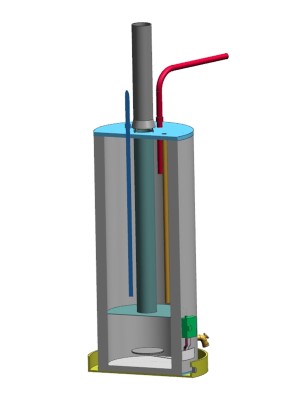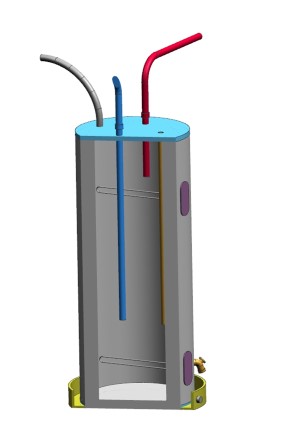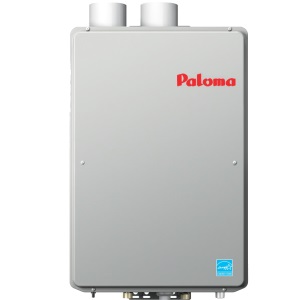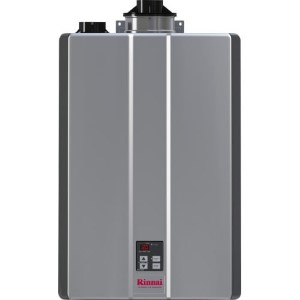- Home
- Water Tank Heater
Choosing the Right Water Tank Heater: A Buyer's Guide
 Rheem
RheemWater tank heaters are like the backbone of hot water in your home. They quietly make sure you have warm water for showers, dishes, and laundry. But not all heaters are the same, and choosing the right one can make your life easier and save you money.
In this guide, we'll break down water tank heaters in simple terms. We'll help you understand your options, explore the advantages and disadvantages, find the most popular sizes and manufacturers of hot water tanks, and even compare tank-type vs. tankless systems. Let's get started and make hot water simple!
Tank water heaters are also known as storage tank type or cylinders. Gas water heaters with storage tanks are the most popular type for water heating in North America where a 50-gallon capacity is a commonly used size.
With the available capacities ranging from 20 gallons to over 100 gallons, water heater tanks are designed as whole-house systems so they can supply hot water to more than one fixture at a time. There are also water heaters with smaller storage tanks, but those are recommended for point-of-use applications. Water storage tank heaters are recommended for homes with constant demands.
Water tank heaters: Things to consider
- Manufacturers
- Types
- How it works
- Selecting tips
- Buying guidelines
- How much does it cost to buy and install a heater
- Tank vs. tankless
Select a manufacturer
Types
Tank water heaters are using gas, electricity and solar energy for heating. As opposed to tankless heaters, the storage-tank type is a simple and economical device where the tank occupies most of the unit. The storage tank is insulated so the heated water can stay hot longer. Every unit made of metal has the anode rod, thermostat, dip tube, TPR valve, and drain valve.
Gas-powered water tank heaters also have a gas valve, burner assembly, gas combustion chamber, and flue baffle (vent).
Almost all new gas water heaters are equipped with the FVIR system that is designed to protect from accidental fire caused by flammable vapors. From the gas burner, through the tank and water stored inside, there is a flue tube that moves the gases out, either naturally (atmospheric vent units) or forced (power vent units).
Most of the gas water heaters use a pilot light to ignite the main burner, while others that are more advanced, use a hot surface or electronic ignition.
Electric water tank heaters are the simplest units that utilize upper and lower heating elements to heat the water.
Solar water tank heaters are storage tanks that store heated water from solar panels, supplemented by heating elements for backup heating.
How does the water tank heater work
 Gas water heater
Gas water heater Electric water heater
Electric water heaterThe operation of a water tank heater is a straightforward process. Inside the heater, there's a storage tank where cold water enters for heating, and it's also where the hot water is stored for use. The incoming cold water flows in from the home's plumbing system through an inlet tube or dip tube, which directs it to the lower part of the tank.
The water heating process depends on the type of heater. Electric water heaters use heating elements, while gas water heaters employ a gas burner. As the water heats up, it naturally rises to the top of the tank. From there, it travels through the plumbing to the hot water tap (when opened) or to an appliance like a dishwasher.
As hot water is drawn from the tank for use, it is immediately replaced by cold water, which enters the tank through the dip tube. This continuous cycle ensures a steady supply of hot water. The thermostat, which monitors the water temperature inside the tank, plays a crucial role in this process. It signals the heater to begin heating when needed by activating the heating element(s). This ensures that the water in the tank remains at the desired temperature, ready for use whenever it's needed.
Things to consider when sizing a water heater
Selecting the right water heater is crucial to ensure that your household has an ample supply of hot water, providing convenience, comfort, and potential savings. To make the best choice, you should consider the following factors:
- Family Size: The size of your family plays a key role in determining the appropriate water heater capacity. A larger family will generally require a larger water heater to meet their hot water needs.
- Number of Hot Water Applications: Take into account how many applications in your home require hot water, such as showers, dishwashers, sinks, and washing machines. The more applications you have, the higher the demand for hot water.
- Usage Patterns: Consider your family members' hot water usage patterns. Do they frequently take short showers, or do they prefer longer, high-flow showers and use hot water for other tasks simultaneously? Understanding these patterns helps determine the heater's ability to meet peak demand.
- Calculate Peak Demand: To calculate the peak demand or the busiest one-hour usage period, you can use the following estimates for hot water usage: 20 gallons for a shower, 2 gallons for shaving, 4 gallons for hands and face washing, 5 gallons for food preparation, 14 gallons for an automatic dishwasher, and so on. By adding up these estimated demands, you can determine your total hot water needs. For example, if your calculations show a need for 50 gallons of hot water during peak usage, it's advisable to purchase a 70-gallon water heater, as this ensures a 70% available volume for meeting your needs.
By considering these factors and making a careful assessment of your household's hot water requirements, you can select the right water tank heater that meets your family's needs effectively and efficiently. This thoughtful choice will ensure that you have a consistent and reliable supply of hot water while potentially saving on energy costs.
Buying tips
When buying a water heater, several factors should be considered to ensure optimal performance and efficiency:
- Energy Efficiency: Buy the energy efficient water tank heaters or Energy Star approved models as they can help you save on utility bills over time.To meet the Energy Star requirements, the Uniform Energy Factor (UEF) has to be 0.67 or higher. UEF is what indicates how efficiently the heat is transferred to the water. Condensing units have the highest efficiency which can be more than 0.9. High-efficiency water heaters are usually equipped with heat traps and have thicker insulation and R-value. For heaters with lower efficiency, it is recommended to use an insulation blanket.
- Fuel Source: Consider the availability and cost of the fuel source for your water heater. Gas heaters may be more cost-effective in some areas, while electric heaters can be more practical in others. Solar and heat pump water heaters are also options for those seeking renewable energy sources.
- Sizing: For a family of four to five, a 50-gallon tank size is often sufficient. Use the following instructions for sizing a water heater. Ensure you have adequate space for the chosen water heater. Tank water heaters can be quite large, so measure the available space before purchasing.
- Installation Costs: Factor in installation costs, which can vary based on the type and size of the water heater. Some models may require modifications to your existing plumbing or electrical systems.
- First Hour Rating: Gas heaters are a good buy as they have higher First Hour Rating than the electrical ones. So, you might need a smaller unit for your water heating needs than the electric.
- Additional features: Look for the tank-type heater with a self-cleaning system as it automatically fights the sediment build-up problem; also green or low NOx burner, high recovery, high performance or high efficient models. Also, buy a heater with a large anode rod or with more than one because such units have an improved warranty and are protected from corrosion. Powered anodes are even better, as they are not sacrificial.
- Environmental Impact: Consider the environmental impact of your choice. Some water heaters are more eco-friendly than others, and you may want to opt for a system that aligns with your sustainability goals.
- Warranty: Check the manufacturer's warranty for the water heater. Longer warranties can provide peace of mind and may indicate the manufacturer's confidence in the product's durability.
How much does it cost to buy and install a water heater?
The average cost of a tank-type water heater can vary significantly depending on several factors, including your location and the specific model and features you choose. Here are some average cost ranges for tank-type water heaters and their installation in both Canada and the United States:
Canada:
- Water heater cost: Between $800 and $1200 CAD
- Installation cost: Between $300 and $400 CAD
- Total cost (including water heater and installation): Approximately $1100 to $1600 CAD
United States:
- Water heater cost: Approximately $1300 or higher for advanced models
- Installation cost (standard tank-type): Between $150 and $600 USD (according to homeadvisor.com)
- Total cost (including water heater and installation for standard models): Approximately $1450 to $1900 USD
As explained by networx.com the installation cost varies according to several factors:
- Size: Larger capacity water heaters tend to be more expensive.
- Power Source: Gas water heaters may have different costs compared to electric ones.
- Style: High-efficiency or condensing models may come at a premium.
- Quality: Premium brands and models with longer warranties can be more expensive upfront.
- Additional Features: Water heaters with advanced features may cost more.
- Location: Prices can vary by region and availability.
- Installation Complexity: The complexity of installation can impact labor costs.
- Plumber's Rates: The rates charged by plumbers for installation and repairs can vary.
Additionally, repair costs for water heaters can range from $100 to $160 on average when hiring a plumber.
To get an accurate estimate for your specific situation, it's advisable to obtain quotes from local suppliers, contractors, or plumbers, taking into account the factors that apply to your needs and location. This will help you determine the total cost of purchasing and installing a tank-type water heater tailored to your requirements.
Tank water heater vs. tankless
 Tank-type
Tank-type Tankless
TanklessThe tank-type water heater generally has a lower upfront cost, as well as lower installation expenses compared to tankless models. It typically features smaller burners and heating elements, along with a less expensive venting system. Another advantage is that it does not require electricity to operate.
However, one drawback of tank-type heaters is standby heat loss. This means that the water is continuously heated, even when not in use, resulting in energy loss through the outer surface of the tank.
On the plus side, a gas tank-type water heater can provide hot water even during power outages, as it does not rely on electricity for operation.
One consideration to keep in mind is that tank-type heaters are free-standing appliances, which means they occupy valuable floor space. Additionally, they may require a dedicated room for proper installation in the case of gas-powered units.
For more in-depth information on the comparison between tankless and tank-type water heaters, you can check out this article, which provides a detailed explanation of the two options.
Conclusion
Opting for a tank-type water heater can be a dependable and cost-effective choice. These heaters are known for their affordability, reliability, and safety. When considering tank-type options, especially condensing or high-efficiency models like the Vertex from AO Smith or Polaris from American, you can potentially achieve significant energy savings.
If you find yourself deliberating between electric and gas models, the natural gas option often proves to be the more economical choice over the long term. It not only tends to be more cost-effective but also provides rapid water heating.
Additionally, keep in mind that Energy Star-rated models are readily available from various manufacturers, further contributing to energy efficiency and savings. Ultimately, selecting a tank-type water heater that suits your specific needs and preferences can provide a dependable and efficient hot water solution for your home.
Related
- Home
- Water Tank Heater


